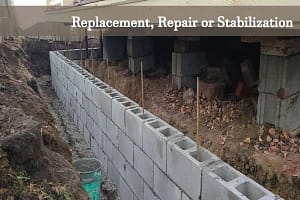What Does Best Basement Waterproofing Mean?
What Does Best Basement Waterproofing Mean?
Blog Article
A Biased View of Best Basement Waterproofing
Table of ContentsOur Best Basement Waterproofing IdeasBest Basement Waterproofing Things To Know Before You BuySome Of Best Basement WaterproofingThe Single Strategy To Use For Best Basement WaterproofingRumored Buzz on Best Basement Waterproofing
uses excavation strategies toward the bottom of the framework's foundation. involves eliminating wetness after it has actually gotten in the basement. AdvantaClean's trained experts and professionals will locate the water source. If wall or piece cracks exist, we will infuse polyurethane and epoxies right into the fractures and secure the concession, protecting against more wetness from getting in.If there's condensation outside of the foil, you have high moisture in your basement. Repair it with a mobile space dehumidifier or a whole-house humidifier system rather than waterproofing products. If the foil has condensation on the within surface (beside the wall), the dirt around your home may be naturally damp from a high water table or poor dirt drainage.
You can waterproof just your interior wall surfaces, which may solve the trouble. Once they dry, they adhere permanently to concrete and stonework walls.
What Does Best Basement Waterproofing Mean?
Concrete waterproof finishings can't be applied to previously painted surfaces; check the tag. Recognized as densifiers, they are appropriate just for wall surfaces that have not been painted or secured.
You comb, roll, or spray it on much even more thickly one gallon covers just 75 square feet, not the 300 square feet typical with conventional paint. Water-proof paint is fine for DIY application. You can apply it over painted surfaces, and paint over it once it's treated (one gallon costs $37).
It can set you back $10,000 to $15,000, depending on the job needed. Outside waterproofing entails digging deep into all around the home to the complete depth of the foundation walls, then setting up a water-proof layer or membrane layer topped by drain panels.
A basement without waterproofing is kind of like that. Your basement doesn't desire to go with a downpour without correct protection just as much as you don't desire to.
Getting My Best Basement Waterproofing To Work
But if you've done your research study, you 'd recognize there are two sorts of waterproofing: interior and exterior. It can get perplexing best site what they both mean, which one's a far better financial investment, and what More Bonuses will in fact keep the water out. Don't worry, we created this blog site to conveniently specify both approaches for you and talk about the pros and cons of each.
Outside waterproofing is a waterproofing method that entails securing your home from the exterior. It's kind of like a moat around a castle. It includes excavating a trench around your whole residence down to the foundation (about 8 to 10 feet down). The foundation wall surfaces are after that cleansed, secured, and covered with a water-proof membrane or sealant.

Indicators on Best Basement Waterproofing You Should Know
It's a much more engaged procedure that calls for excavating up your backyard, which is expensive and time-consuming. Exterior waterproofing entails getting rid of whatever bordering your home, including decks, driveways, walkways, landscaping, air conditioner devices, decks, and more. If any one of the work was done incorrectly and water is still entering your basement, there isn't much you can do to correct or fix it.
Interior cellar waterproofing entails waterproofing from the within. Any type of water that leaks into your basement is rerouted prior to it touches your flooring.
It's an effective approach to waterproof your basement. The disadvantage of indoor cellar waterproofing mainly has to do with the setup procedure.
Examine This Report about Best Basement Waterproofing
Finally, exterior and interior basement waterproofing are both effective approaches of protecting your home from water damages. Outside waterproofing creates an obstacle that avoids water from entering your home, while indoor waterproofing redirects water that does enter your home. And it is necessary to note that exterior waterproofing is a pricey and turbulent installation procedure when contrasted to indoor waterproofing.
Whichever method you select, ensure you pick a dependable and reliable professional for the work. Both methods call for experienced employees to handle the work. If you have any kind of inquiries regarding basement waterproofing, please connect to us. And if you're in our service area and have water in your cellar, call us for a complimentary, no-obligation home assessment.
You can complete our type below, begin a conversation in the lower right-hand corner, or call us at 1-800-827-0702.
Report this page